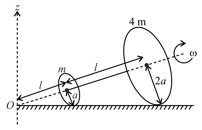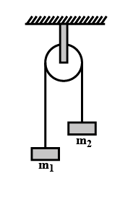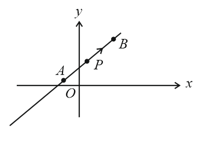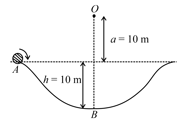A planet revolves around a massive star in the elliptical orbit shown. Point A on the orbit corresponds to perigee. Consider motion of the planet from position P to position Q. About A, angular momentum of the planet

Important Questions on Physical World and Measurement
| Column I | Column II | ||
| A | Stoke's law | I | Pressure and energy |
| B | Turbulence | II | Hydraulic lift |
| C | Bernoulli's Principle | III | Viscous drag |
| D | Pascal's law | IV | Reynold's number |
The correct match is
Two thin circular discs of mass and , having radii of and , respectively, are rigidly fixed by a massless, right rod of length through their center. This assembly is laid on a firm and flat surface, and set rolling without slipping on the surface so that the angular speed about the axis of the rod is . The angular momentum of the entire assembly about the point is (see the figure). Which of the following statement(s) is(are) true?


(A) Ratio of the relative strength of gravitational to weak force is nearly
(B) Ratio of the relative strength of gravitational to weak force is less than
(C) Ratio of the relative strength of strong nuclear to electromagnetic force is nearly
(D) Ratio of the relative strength of strong nuclear to electromagnetic force is nearly .
Which of the following is true?
A particle is moving uniformly along a straight line as shown in the figure. During the motion of the particle from to , the angular momentum of the particle about

A particle of mass is on a smooth horizontal table and moves in a circular path of radius . The height of the table from the ground is . If the angular speed of the particle is , the magnitude of its angular momentum about a point on the ground right under the center of the circle is:

(a) Gravitational force
(b) Weak Nuclear force
(c) Electromagnetic force
(d) Strong Nuclear force

